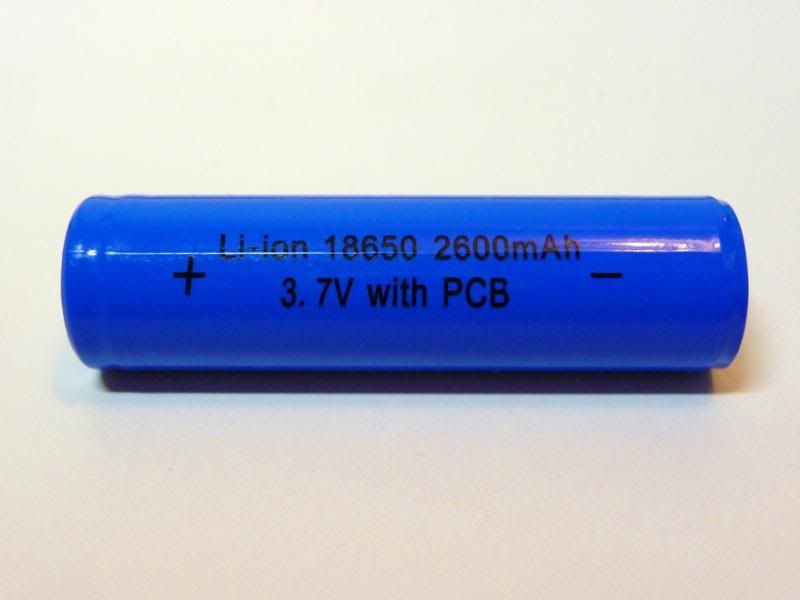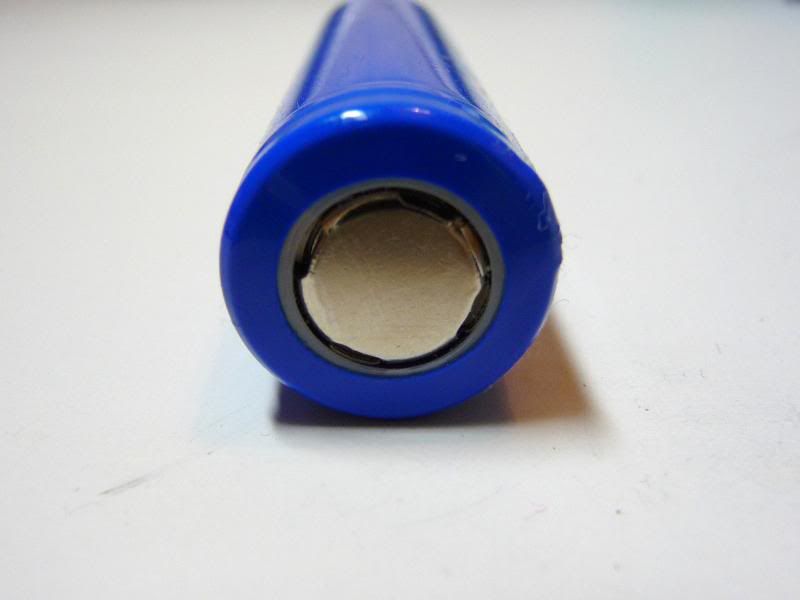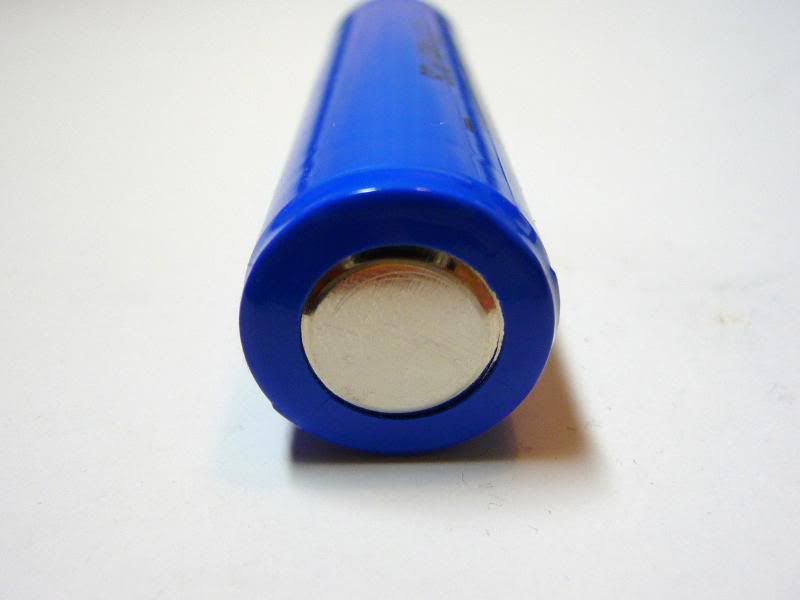
Just a quick review on this one.
Having purchased a number of different pairs of 18650 batteries from a UK Ebay dealer, 'big_f_d_d', he kindly sent me a single 'Ridbatt' 2600mAh protected cell to try. As such, I can only present the performance of this one cell, and cannot comment on cell matching, but let's be honest here, just how much can you really tell from testing a pair of cells? Just because two match well, doesn't mean that a 3rd cell would match those. Or a fourth or fifth, etc. Testing a pair of cells tells you more than just testing one, but you'll never really see the full picture without testing a considerably larger number.
I did some quick testing and sent him the results. As such, this cell has seen a little use prior to this more comprehensive test, and my initial internal resistance result is from the cell after a storage charge, not the voltage that the cell arrived with when delivered.
big_f_d_d now sells these cells as his 'Torchy' branded 2600mAh batteries.
Testing equipment
A quick re-cap of the equipment used for testing: -
I will be charging cells with an iCharger 106B+, and discharging and testing internal resistance with an iCharger 208B. Two chargers are used for speed and convenience – one cell can be charging while a second is being discharged (not relevant in this instance). I use the same charger for each step to ensure consistency in conditions between tests, so that results are comparable.
Voltage is measured with a Precision Gold WG 020 multi-meter, dimensions with a Precision Gold digital calliper, and weight with a Neva digital scale stated to be accurate to 1/100th of a gram.
The base of the cell is attached to the charger via a 12” 16AWG cable with a large, strong magnet soldered to it. The positive button is attached via a magnet (if it adheres well) or via a crocodile clip. In this case, the magnets adhered well at both ends.
Results at a glance
Provided for testing by Ebay UK member ‘big_f_d_d’
This cell is now sold by big_f_d_d in packs of two for £10.49 with free shipping and Ultrafire battery case.
|
|
Cell 1 (1) |
|
Storage voltage |
3.74V (2) |
|
Measured length |
67.25mm |
|
Measured width (max) |
18.63mm |
|
Weight |
46.22 grams |
|
Internal resistance at initial voltage |
129mOhm (2) |
|
Capacity from storage down to 3.00V |
671mAh |
|
Internal resistance after storage charge |
135mOhm (3) |
|
Capacity from 4.2V down to 3V @ 0.5A |
2541mAh |
|
Capacity from 4.2V down to 3V @ 1.0A |
2501mAh |
|
Capacity from 4.2V down to 3V @ 3.0A |
2452mAh |
|
Capacity from 4.2V down to 3V @ 5.0A |
1012mAh (4) |
|
Capacity from 4.2V down to 3V @ 4.8A |
1926mAh (4) |
|
Capacity from 4.2V down to 3V @ 4.6A |
2315mAh (4) |
(1) This cell was supplied to me for testing along with a number of cells that I purchased from Ebay. As such, I only have the one cell to test.
(2) This cell has already seen some testing and so is no longer at it’s initial voltage as received. As such, the voltage and internal resistance has been taken after giving the cell a storage charge.
(3) The discrepancy between the two internal resistance readings, both at storage charge voltage, may be due to differing temperature at time of measurement. I don't believe that any degradation has occurred to the cell just from a low rate discharge from storage voltage to 3V!
After all the above discharges were completed, I gave the cell another storage charge, it was 10pm, cooler, and got a reading of 117mOhm.
(4) With a 5A discharge, the charger registered a connection error prior to the discharge terminating at 3.0V. As the cell was far from being under or over voltage at that point, I would have to presume that the protection circuit cut in due to the current draw. As over 1000mAh of energy had already been released, I would guess that the cut off point is right around 5.0A, and a small spike in the current caused the protection circuit to trip. However, I cannot see any evidence of a current spike occurring in the data.
I tried again with a discharge rate of 4.8A, and was able to release 1926mAh of energy, but again, the protection tripped prior to the voltage dropping to 3.0V. Worth pointing out that capacity was pretty good here despite the early cut off. Again, there was no record of a current spike having occurred.
In light of this, I wonder if it is actually thermal protection coming in to play, rather than excess current. Having said that, the cell was not excessively hot on discharge, but maybe the thermal protection on this cell is set on the cautious end of the scale - better safe than sorry.
I dropped the discharge rate down to 4.6A, and was able to complete a full discharge at that setting.



Construction
This cell has a vinyl like heat shrink wrap, rather than the more brittle 'tape' like wrap that some cells have.
The positive contact is a flat top, slightly recessed behind the cell's wrap. The contact is chrome or nickel plated steel. Finally, my magnets were able to do a good job, and didn't keep trying to stick to the shoulder of the cell!
The base of the cell is a metal plate, also chrome or nickel plated. The metal base should offer good wear resistance, and as long as it isn't chipped, nickel or chrome are very hard, which should also help in this respect. Unlike the posive contact, the base plate is actually dished out a little. This may actually help to make contact when running these cells in series, but the recessed tip obviously doesn't help making contact inside a light with physical reverse polarity protection, as can be seen in the light compatibility chart below.
Light compatibility
|
Light |
Characteristics |
Fits |
Functions |
|
Olight M20 |
Wide tube, spring at head, sprung plunger at tail cap |
Yes |
Yes |
|
SWM T20CS |
Short tube, dual springs |
Yes |
Yes |
|
Jet IIIM |
Wide tube, tail spring only |
Yes |
Yes |
|
Fenix TK15 |
Two-piece tube – narrow at head Short tube, short spring at head |
Yes |
Yes |
|
Fenix TK11 |
Narrow tube, tail spring only |
No – too wide |
N/A |
|
Eagletac G25C2 |
Wide tube, sprung plunger at head and tail (minimal travel at the head end), physical reverse polarity protection |
Yes |
No – positive button too flat |
|
Nitecore IFE2 |
Narrow tube, physical reverse Polarity protection |
Yes – very snug |
No – positive button too flat |
Charger compatibility
|
Charger |
Fits |
Functions |
|
4Sevens single bay |
Yes |
Yes |
|
Trustfire TR-001 |
Yes |
Yes |
|
Ultrafire WF-139 |
Yes |
Yes |
|
Ultrafire WF-188 |
Yes |
Yes |
|
HXY-042V2000A |
Yes |
Yes |
|
XTAR WP2 II |
Yes |
Yes/No (5) |
|
Pila IBC |
Yes |
Yes |
|
Jetbeam/Sysmax Intellicharge i4 |
Yes |
Yes |
(5) With the WP2 II, the cell charged in one bay, if the cell were pushed up against the charger's positive terminal. In the other bay, the cell wouldn't charge at all. If a small, thin disk magnet were attached to the positive end of the cell, charging occurred in both channels. This issue is caused by the cell's flat, slightly recessed positive contact, but was not an issue in any of the other chargers.
Internal resistance
|
Cell |
Voltage |
Internal resistance |
|
Ridbatt 2600mAh #1 |
3.74V (storage charge) |
129mOhm |
|
Ridbatt 2600mAh #1 |
3.74V after initial capacity test (storage charge) |
135mOhm |
|
Ridbatt 2600mAh #1 |
3.74V all testing complete (storage charge) |
117mOhm |
|
Xtar 2600mAh #1 |
3.85V (as received) |
139mOhm |
|
Xtar 2600mAh #2 |
3.79V (as received) |
136mOhm |
|
Keeppower 2600mAh #1 |
3.78V (as received) |
123mOhm |
|
Keeppower 2600mAh #2 |
3.78V (as received) |
119mOhm |
|
Hi-Max 2600mAh #1 |
3.79V (as received) |
153mOhm |
|
Hi-Max 2600mAh #2 |
3.80V (as received) |
163mOhm |
Conclusion
Apologies for sounding pretty positive in all my reviews so far. Fact is that - after some pretty naff Ultrafire and Trustfire cells that I have purchased in the past - I now only purchase cells that I think may be good. While I didn't pay for this one, I would happily have paid for this.
I was a little concerned about the initial increase in internal resistance I measured after discharging the cell from it's storage charge, and then measuring it again after another storage charge. Admittedly, the difference was actually tiny, but I wanted to see if it would continue to increase after more testing. At then end of all the testing, and under different conditions, the IR actually dropped a fair amount, so that small increase under one set of conditions was not cause for concern.
Maximum capacity was a little lower than claimed, but nothing major. Perhaps with a different charger, or different temperatures, or a lower resistance set of cables, the measured capacity would have been higher still. I'd have to say that the capacity is pretty honestly rated here.
The cell made up for this slight reduction in overall capacity by maintaining it pretty well as the discharge rate increased. I couldn't complete a 5A discharge for whatever reason, or 4.8A, but a 4.6A (and 4.7A might be possible - this discharge rate was not tested) discharge ran to termination, and gave a respectable capacity of 2315mAh down to 3V.
It's hard to give a cell a solid recommendation before I have carried out tests on other 2600mAh cells to make a comparison, but if I had to stick my neck out, and just judged this cell on face value, I'd have to say it was a good cell. If your light doesn't have problems with flat topped cells, and doesn't draw over 4.6A, and you are looking at trying some different cells (AW and Redilast too expensive, Ultrafire too inconsistent), then you wouldn't go far wrong by giving these a try - particularly if you are a UK'er, and want to get hold of your batteries quickly.
